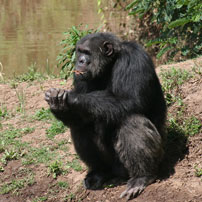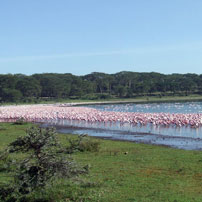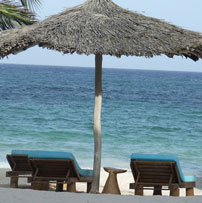 I have enjoyed another educational trip around Kenya, and like my previous experiences, I have been totally blown away by the amazing wildlife and exclusivity that Kenya offers, as well of course by the friendliness of the people!
I have enjoyed another educational trip around Kenya, and like my previous experiences, I have been totally blown away by the amazing wildlife and exclusivity that Kenya offers, as well of course by the friendliness of the people!
I started in Meru National Park and then headed westwards through some gorgeous Laikipia scenery and the Ol Pejeta Conservancy to reach the Great Rift Valley lakes of Naivasha and Nakuru, ending my trip with a few nights exploring new properties on the south Mombasa Coast.
I was incredibly excited about returning to Meru National Park after an absence of 7 years, as this park is a personal favourite of mine in Kenya – and this visit has just enhanced my enthusiasm of this special, rather ‘hidden’, gem. The first thing you notice when you land is the heat (at 2500 feet Meru is much lower than many other parks). As you drive out from the airstrip you will also notice the trail of red dust behind the vehicle, dust that during the dry season will become part of your experience! However, you are immediately hit by the beauty of the landscape. The riverine forests, the open plains, the backdrop of the Nyambene Hills and the many rivers and swamps that dominate the park create a truly magical part of the world. And the wildlife is good too – we have many reports from guests of the increasing number of animals and the variety of species. Elephant are everywhere, cat sightings are improving season on season, 65+ rhino within a recently extended rhino sanctuary, and more specialist ‘northern’ species such as Reticulated giraffe, gerenuk and Lesser kudu. It is not the Masai Mara but you never go too long without seeing something special, and with so many small streams and swamps, the birdlife is superb. But the real beauty of Meru is the exclusivity. The entire park has very few camps or lodges and most sightings you have entirely to yourself. If you are looking for a bit more comfort, better known Elsa’s Kopje is built into the side of a hill with expansive views across the park.
 Ol Pejeta Conservancy lies on the equator and affords wonderful views of Mount Kenya. The private conservancy offers 90000 acres of beautiful landscape and an un-crowded environment to enjoy quality game-viewing and birding. The Conservancy is home to Kenya’s largest populations of black rhino, large numbers of elephant, lion, cheetah, leopard, wild dog and plentiful plains game. There are also a number of the rarer Northern species such as the Grevy’s zebra, Jackson’s Hartebeest, Beisa oryx and Reticulated giraffe. There are a few properties to consider in Ol Pejeta, I stayed at Kicheche Laikipia which has a fantastic location in the heart of the conservancy and overlooks a large waterhole which animals often visit. After my work for the day, I enjoyed a short game-drive where I ticked 33 species of birds in just one hour (click here to see my bird list). Whilst being totally engrossed in our bird watching we also managed to stumble across a leopard too! I also re-visited the chimpanzee sanctuary for orphaned/rescued animals – not quite ‘in the wild’ but certainly a highlight of a visit to the conservancy.
Ol Pejeta Conservancy lies on the equator and affords wonderful views of Mount Kenya. The private conservancy offers 90000 acres of beautiful landscape and an un-crowded environment to enjoy quality game-viewing and birding. The Conservancy is home to Kenya’s largest populations of black rhino, large numbers of elephant, lion, cheetah, leopard, wild dog and plentiful plains game. There are also a number of the rarer Northern species such as the Grevy’s zebra, Jackson’s Hartebeest, Beisa oryx and Reticulated giraffe. There are a few properties to consider in Ol Pejeta, I stayed at Kicheche Laikipia which has a fantastic location in the heart of the conservancy and overlooks a large waterhole which animals often visit. After my work for the day, I enjoyed a short game-drive where I ticked 33 species of birds in just one hour (click here to see my bird list). Whilst being totally engrossed in our bird watching we also managed to stumble across a leopard too! I also re-visited the chimpanzee sanctuary for orphaned/rescued animals – not quite ‘in the wild’ but certainly a highlight of a visit to the conservancy.
Naivasha and Nakuru do not offer the exclusivity and wilderness of the Laikipia Region or Meru National Park, but both areas are beautiful and the lakes of course a highlight! Lake Naivasha is not a ‘big game’ destination, the area is better known for its flower farms, but there are some lovely small lodges on private conservancies bordering the lake. Whilst staying at Chui Lodge, I was rather spoiled with a bush breakfast overlooking the picturesque, smaller, and lesser known, Lake Oloidien, which was teeming with birds  including thousands of flamingos – a real treat! Lake Nakuru is only an hour’s drive north of Naivasha and can easily be visited on a day trip from Naivasha, enjoying a picnic lunch in the park. Lake Nakuru will offer more guaranteed big game-viewing and is particularly good for white rhino – I actually lost count of how many we spotted on our morning game-drive! The lake itself is beautiful and of course well known for its large flamingo populations although due to the ever changing weather patterns it is becoming increasingly difficult to predict the best time to visit the lake to see the flamingos.
including thousands of flamingos – a real treat! Lake Nakuru is only an hour’s drive north of Naivasha and can easily be visited on a day trip from Naivasha, enjoying a picnic lunch in the park. Lake Nakuru will offer more guaranteed big game-viewing and is particularly good for white rhino – I actually lost count of how many we spotted on our morning game-drive! The lake itself is beautiful and of course well known for its large flamingo populations although due to the ever changing weather patterns it is becoming increasingly difficult to predict the best time to visit the lake to see the flamingos.
A safari in Kenya is often combined with some relaxation time on the coast. It is true to say that the Mombasa coastline is known for its larger, resort hotels and busy beaches, but I am pleased to report there are smaller, more personal properties that have popped up in the last few years! Kinondo Kwetu and Msambweni House are both upmarket, with lovely accommodation, delicious fresh food, personal service and quieter locations. More affordable options are Waterlovers and Diani Blue both of which are owner run guesthouses with warm hospitality, great food, and friendly, personal service. Finally the last property that really stood out to me was Tijara Beach Lodge, built on the edge of a cliff with stunning ocean views. It does not have the long white sandy beach but does have a small private beach, is owner run, and with just four cottages is very peaceful and exclusive!
 I always find it slightly frustrating when I hear people claiming that Kenya is only good for mass-market safari or beach holidays. It is so far from the truth! If you know where to go, Kenya has more exclusive safari options than many other parts of Africa, especially if you are keen for a diverse experience. The hospitality on offer is rarely matched anywhere else, and Kenya still offers better value for money and better family options than most other African countries. Kenya will always have something for everyone!
I always find it slightly frustrating when I hear people claiming that Kenya is only good for mass-market safari or beach holidays. It is so far from the truth! If you know where to go, Kenya has more exclusive safari options than many other parts of Africa, especially if you are keen for a diverse experience. The hospitality on offer is rarely matched anywhere else, and Kenya still offers better value for money and better family options than most other African countries. Kenya will always have something for everyone!

